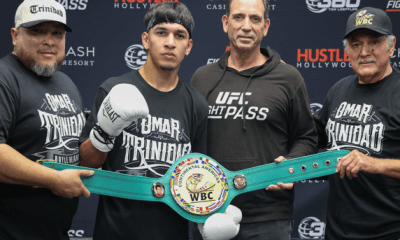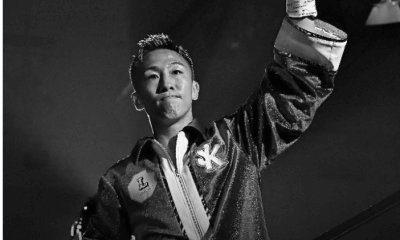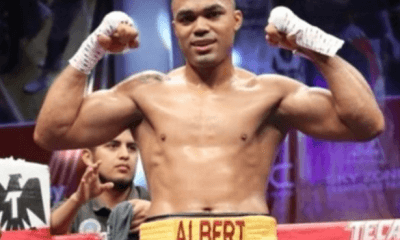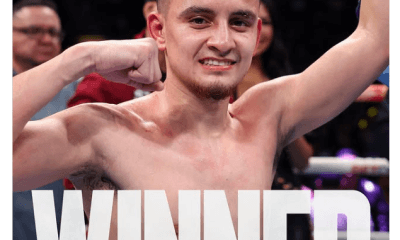Featured Articles
Art of Boxing Series – Tim “Desert Storm” Bradley (Part Two)

Tim Bradley appeared on the professional boxing circuit like an unpinned grenade and exploded on the Southern California scene.
When Bradley began fighting regularly under the Thompson Boxing banner and defeating veterans and fellow prospects with ease, the biggest questions were how far can he go and where did he come from?
Thompson Boxing Promotions was barely in its fourth year of existence and suddenly and surprisingly had a fighter with amazing fighting skills and an aptitude to match. The matchmaker and head of operations Alex Camponovo was handed the duty of guiding the early career of Bradley.
It was quite an experience to see Bradley perform on club shows in Ontario and see him electrify audiences with his abundance of talent. It was simply no-contest as he buzz-sawed through the competition with his speed and quick reflexes.
I remember wondering how the bigger boxing promotion companies missed signing Bradley. At the time, Top Rank and Don King Productions were at the top of the heap and Main Events had some pretty good fighters too. Golden Boy Promotions had started a few years earlier but was in its infant stage.
So how did every one of these companies miss Bradley?
One thing that did seem apparent was his size. He was small at 140 pounds and too muscular to drop down to 135-pound lightweight. Though he showed outstanding speed, his power was not what other fighters at the super lightweight class were able to do and that’s to deliver eye-popping knockouts.
But Bradley could out-box almost anyone’s socks off and not by running.
Thompson Boxing’s matchmaker Camponovo, who was also brand new to the boxing world, realized he needed to move Bradley quickly. Both Camponovo and Bradley were relatively unknown to the boxing powers and that was an advantage early.
Conversely, being new to the game caused unexpected problems.
The first time Thompson Boxing staged a Bradley fight outside of his power base in the Inland Empire, problems arose. A fight card was held at the L.A. Athletic Club in downtown Los Angeles and Bradley was set to face a Brazilian fighter named Marcos Andre Rocha Costa.
According to his record he had one fight and one loss. But no way to verify if that was indeed Rocha Costa. When he appeared in the boxing ring, the Brazilian was about seven inches taller and a southpaw.
Bradley walked into the ring on July 21, 2005 eager to please the crowded venue that had people hanging over the side of an elevated running track that surrounded the ring. Everyone was excited.
Immediately both fighters engaged in high volume punching and it was apparent that the taller Brazilian was extremely talented. Around the third or fourth round, Rocha Costa connected solidly and buzzed Bradley who teetered a bit. It could have been the end. Instead, Bradley erupted in the next round and slipped into another gear that Rocha Costa could not match. Referee Pat Russell stopped the fight as Bradley had battered his way to victory by knockout.
It was an impressive turnaround.
After the fight, the Brazilian fighter surprisingly said he had seven wins and one loss. Both Bradley and Camponovo had dodged a tremendous bullet.
Bradley returned to the Inland Empire and racked up more wins at the Doubletree Hotel and Omega Products International, including a victory that handed him the WBC Youth title that ranked him in the top 20. Those wins also led to a co-promotional deal with Gary Shaw Productions who had a television deal with Showtime.
But first, he needed to beat Africa’s Nasser Athumani who had 24 pro fights and 17 wins by knockout when they met on April 13, 2007.
“I fought a guy named Athumani, an African guy, and he hit hard like a son-of-a-gun. That guy could punch,” said Bradley about the southpaw slugger from Kenya. “He had more knockouts than I had fights and he hit me with an uppercut in the first round. I ended up stopping him but I don’t remember anything about the fight. I was out man.”
Another big moment arrived a few months later on July 27, 2007 when he met Mexico’s rising star Miguel “El Titere” Vazquez who had only one loss. That single Vazquez loss was on his pro debut against a youngster named Saul “Canelo” Alvarez. He had not lost another fight since when he stepped in the outdoor boxing ring at Omega Products International in Corona, California.
“He broke my rib, man. I fought from the second round on with a broken rib,” said Bradley of his confrontation with Vazquez who would later become a world champion in the lightweight division.
Bradley was promised a world title shot if he could defeat Vazquez. When he suffered the broken rib early in the fight, his trainer Joel Diaz asked him if he wanted to stop the fight and lose his place in line for the world title
“I had to bite the bullet or the title and everything we worked for was down the drain if I quit. I had to fight. I had to bite down and go through the pain and it hurt every time I threw a punch. Vazquez had no clue he hurt my ribs. I didn’t show it. We were taught that. He was extremely tough,” said Bradley of that fight against the future lightweight world champion.
Bradley won the fight by unanimous decision using primarily a jab.
World Titles or Bust
Junior Witter was a clever switch-hitting speedster in the mold of Prince Naseem Hamed and grabbed the WBC super lightweight title with a unanimous decision over DeMarcus “Chop, Chop” Corley. He was coming off back-to-back knockout wins over Arturo Morua and Vivian Harris when he met Bradley in Nottingham, England on May 10, 2008.
Bradley and his team arrived early and immediately discovered that being the challenger was indeed a challenge.
First, his corner man Samuel Jackson was denied entry into the country because of his name. The actor Samuel Jackson had been banned from returning to the United Kingdom for an earlier incident. So, when Bradley’s corner man of the same name arrived, he was blocked at the airport for a long while until the mix-up was cleared. Then, when they arrived for their room, they discovered it was too small for everyone to fit.
No problem, they just found more rooms.
Bradley confessed to being totally prepared for Witter. He also knew that he was unknown to the champion and the crowds expecting to see Witter blow out the American called “Desert Storm.”
“It was one of those things. They didn’t know me. When you fight guys from other countries you don’t know what they have,” said Bradley who had prepared diligently for Witter for more than a year studying film.
As an amateur Bradley was taught by Hall of Fame trainer Al Mitchell to study film of prospective opponents. He had sat with the trainer many times as an amateur in Marquette, Wisconsin looking at tapes of other fighters and breaking down their strengths and assets.
Bradley retained the habit of studying opponents and used it as a weapon. When he faced Witter he was more than prepared for battle despite the crowd.
“I would study him every night for at least an hour and a half. I would just try to come up with a game plan,” said Bradley. “He was so awkward there wasn’t one thing I could do. But he made mistakes pulling back. I had to set things up. I knew I had a bigger gas tank. He would fade in the second half and I had to come out stronger in the second half.”
Witter was also open for an overhand right and Bradley connected in the sixth round to change the momentum drastically and push the fight in his own favor. After 12 rounds Bradley was declared the winner by split decision.
“I caught him by surprise,” said Bradley. “He didn’t know anything about me.”
Neither did American fans at the moment, when Bradley returned to his own country with the WBC title wrapped around his waist. But that would change quickly as he faced a murderer’s row in the super lightweight division.
Beginning in September 2008, Bradley faced Edner Cherry, WBO titlist Kendall Holt, Nate Campbell, undefeated Lamont Peterson, undefeated Luis Abregu, undefeated Devon Alexander and then Joel Casamayor in succession and emerged without a defeat.
In two of the fights against Peterson and Alexander, the Palm Springs area fighter was the underdog and passed each foe with dominating performances.
It was hefty stuff but, after Casamayor, his next fight would be the test of all tests when he met Manny Pacquiao at the MGM Grand in Las Vegas on June 9, 2012.
Pacman and Marquez
Pacquiao had just defeated Mexico’s masterful counter-puncher Juan Manuel Marquez by majority decision in yet another close fight in their third meeting. The speedy southpaw was looking for someone other than Marquez and signed to fight Bradley on June 2012.
In a match that featured two speedy and under-sized welterweights, Bradley seemed more energetic throughout the 12-round fight while Pacquiao seemed to take his foot off the pedal for two minutes each round. Then the Filipino superstar would increase the intensity in the last minute or so and attempt to basically steal the round.
It worked with one judge, but two others saw Bradley the more dominant fighter and he won the WBO welterweight title by split decision. Pacquiao and his fans were incensed and to this day Bradley gets attacked through social media by the keyboard minions whenever the subject arises.
“The first fight was the biggest disappointment and that changed me. It was actually a blessing and a curse at the same time. I got my opportunity to fight Manny Pacquiao and be able to make big time money,” said Bradley about the after-effects. “But after the fight I was ridiculed and demonized. But now there is nothing that can faze me. It’s turned me into a man that can accept any kind of criticism. It doesn’t matter what anybody says to me. The curse is I would never have that victory. It would never be fulfilling to me.”
But it’s in the record books. Forever.
That fight changed Bradley and also might have changed Pacquiao too. Right after the Bradley loss, he signed to fight Marquez a fourth time six months later. Pacquiao exchanged knockdowns with the Mexican fighter and then ran into a Marquez right cross that knocked him out. It was the most decisive win between the two.
Pacquiao would fight Bradley again in two rematches but not before the Palm Springs fighter defeated Marquez by split decision on October 2013. It remains Bradley’s most satisfying win of his career.
“I beat Marquez after he knocked Manny out,” said Bradley of his fight with Marquez that took place at the Thomas & Mack Center in Las Vegas on October 2013. “That was my most fun fight.”
Bradley said he had always studied Marquez, especially in his fights against Pacquiao; and he picked up a few clues about the Mexican counter-puncher that he calls “the perfect fighter” and one of the best in boxing.
“I countered the counter. Fighters at the top level, every time your hand leaves your face you got to expect something to come back. They have a high IQ and are quick on the trigger,” said Bradley about fighting top opposition. “Marquez is probably the second- best counter puncher. Floyd (Mayweather) is the best. I knew something was going to come back. I knew I had to finish and I had to be first and I had to be last.”
The plan worked smoothly and Bradley won by split decision.
“I fought the game plan I wanted to fight. I had fun. It was the easiest $4 and half million I ever made in a fight. It was so easy,” said Bradley.
After Marquez came Pacquiao in the rematch. In fact, he would fight Pacquiao a third time too and lose both by decision.
“He beat me fair and square,” said Bradley about the two losses to Pacquiao.
Bradley lost only two fights in his entire pro career and both were to Pacquiao. That’s a pretty incredible career feat and proves his mastery of the art of boxing. He was never known as a knockout puncher nor did he have size or long arms. He simply used tools he was born with to the umpteenth degree.
Still Studying
Today, Bradley is part of ESPN’s team of boxing commentators alongside Joe Tessitore, Bernardo Osuna, Mark Kriegel, and fellow boxer Andre Ward.
Just as he did as a fighter, Bradley prepares like a demon when it comes to analyzing upcoming fights. He finds it strange that many active prizefighters do not study their opponents.
“You have to be a student of the game. I don’t understand how you don’t do that. None of these guys study opponents or study boxing. I don’t understand how you don’t watch your sport. I don’t get it,” said Bradley of those who don’t study film of old fights or prospective foes.
Studying upcoming match ups is what he still does when at home.
“I still watch boxing today. I just love the craft of it. I love the sweet science of it. I love where the underdog learns to beat the favorite,” said Bradley on the preparation through film study.
As part of the ESPN television commentating team he’s developed a reputation for being straight up.
“They call me the Charles Barkley of boxing,” jibes Bradley of former basketball’s star Barkley’s reputation doing basketball analysis for TNT. “I make my opinion based on my knowledge of the sport. I’m not one of those guys that say all the Top Rank guys are going to win. I thought Deontay Wilder was going to win. I’m not one of those biased types.”
Like fans, fighters and everyone who loves the sport of professional boxing, he looks forward to the return of prizefighting when this worldwide epidemic ends.
“I love my job. I love being around the guys and the game. Being around Andre Ward, Bernardo Osuna, Tessitore and Mark Kriegel, honestly, I think we are the best,” said Bradley, 36. “I’m the crazy one.”
Crazy about boxing.
Check out more boxing news on video at The Boxing Channel
To comment on this story in The Fight Forum CLICK HERE
-

 Featured Articles3 weeks ago
Featured Articles3 weeks agoThe Hauser Report: Zayas-Garcia, Pacquiao, Usyk, and the NYSAC
-

 Featured Articles2 weeks ago
Featured Articles2 weeks agoOscar Duarte and Regis Prograis Prevail on an Action-Packed Fight Card in Chicago
-

 Featured Articles7 days ago
Featured Articles7 days agoThe Hauser Report: Cinematic and Literary Notes
-

 Book Review3 days ago
Book Review3 days agoMark Kriegel’s New Book About Mike Tyson is a Must-Read
-

 Featured Articles4 weeks ago
Featured Articles4 weeks agoManny Pacquiao and Mario Barrios Fight to a Draw; Fundora stops Tim Tszyu
-

 Featured Articles3 weeks ago
Featured Articles3 weeks agoArne’s Almanac: Pacquiao-Barrios Redux
-

 Featured Articles2 weeks ago
Featured Articles2 weeks agoRemembering Dwight Muhammad Qawi (1953-2025) and his Triumphant Return to Prison
-
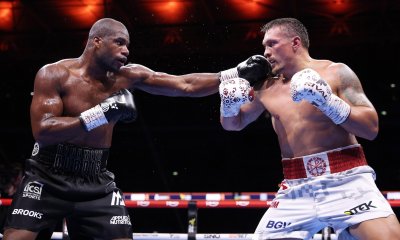
 Featured Articles4 weeks ago
Featured Articles4 weeks agoOleksandr Usyk Continues to Amaze; KOs Daniel Dubois in 5 One-Sided Rounds


